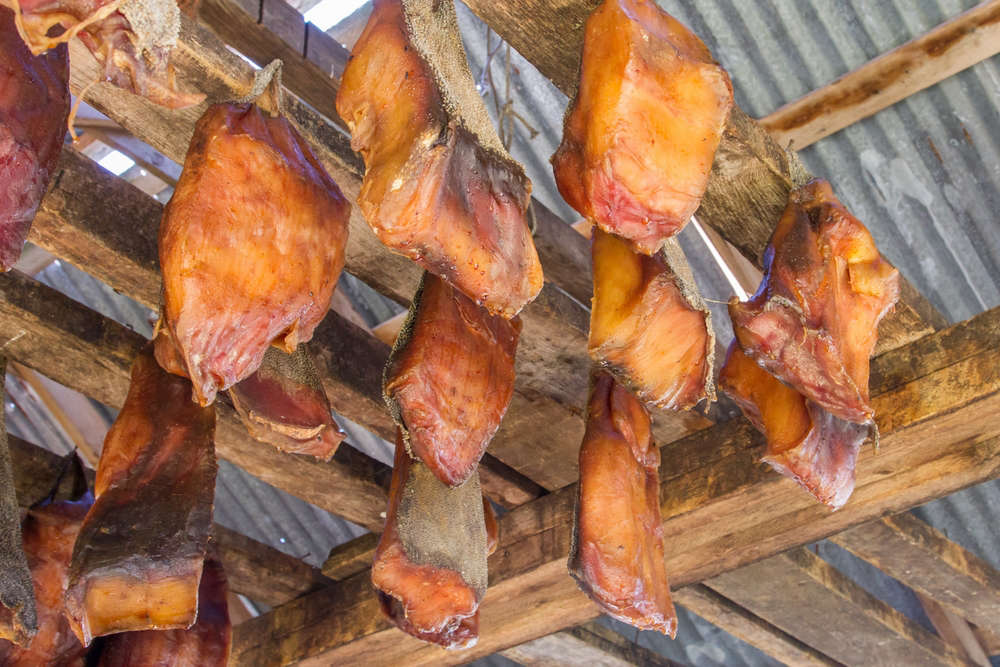
Europe is a culinary paradise with a rich tapestry of flavours and traditions. Each country boasts its unique gastronomic delights, offering a glimpse into its history and culture through food. While many European dishes have become global favourites, there are some exotic meals that are lesser-known but equally tantalizing. That said, you probably need to have a very wide palate to give a few of these a go:
1. Hákarl, Iceland:
Hákarl is perhaps one of the most adventurous dishes you can try in Europe. This traditional Icelandic dish consists of fermented shark, specifically the Greenland shark, which is toxic when fresh but safe to eat after a long curing process. The preparation involves burying the shark meat underground for several months to ferment, followed by hanging it to dry for another few months. The result is a pungent delicacy with a strong ammonia smell and a fishy taste. Hákarl is often served in small cubes and accompanied by a shot of Brennivín, a local schnapps, to help wash it down.
2. Casu Marzu, Italy:
This is not one to try making at home. Casu Marzu, meaning "rotten cheese," is a traditional Sardinian delicacy that takes cheese-making to an extreme level. This sheep's milk cheese is intentionally infested with live insect larvae, which promote fermentation and create a soft, creamy texture. The larvae can jump if disturbed, so the cheese is often eaten with caution. Casu Marzu has a strong, tangy flavour and a texture that can range from creamy to almost liquid. Although it is banned by the European Union due to health concerns, it incredibly remains a sought-after treat for adventurous food lovers visiting Sardinia.
3. Surströmming, Sweden:
Surströmming is a traditional Swedish dish that pushes the boundaries of the senses, to put it politely. This fermented Baltic herring is known for its extremely strong smell, often described as one of the most pungent foods in the world. The herring is caught in spring, salted, and left to ferment for several months. It is typically eaten outdoors due to its powerful odour, which can be overwhelming in enclosed spaces. Surströmming is usually served with flatbread, potatoes, onions, and sour cream, and is a true test of culinary bravery for those willing to experience it.
4. Frog Legs, France:
Frog legs, or "cuisses de grenouille," are a classic French delicacy that might surprise some with their delicate flavour and tender texture. Often compared to chicken or fish, frog legs are usually sautéed in butter and garlic, and sometimes served in a creamy sauce. They are particularly popular in the region of Burgundy, where they are often paired with local wines. Frog legs offer a taste of French culinary innovation, showcasing how the French can transform simple ingredients into gourmet dishes.
5. Smalahove, Norway:
Smalahove is a traditional Norwegian dish that consists of a sheep's head, which is typically boiled or steamed for several hours. The preparation process involves singeing the head to remove fur, then splitting it and removing the brain. The remaining parts, including the eyes and tongue, are considered delicacies. Smalahove is usually served with potatoes and rutabaga, and is particularly popular in the western regions of Norway, especially around Christmas time. The meat is tender and flavourful, and the dish provides an authentic taste of traditional Norwegian cuisine.


 Five Of The Most Wondrous Ancient Ruins In The World
Five Of The Most Wondrous Ancient Ruins In The World
 Five Of The Most Inhospitable Places on the Planet
Five Of The Most Inhospitable Places on the Planet
 Five Animals You Wouldn’t Believe Are Kept as Pets
Five Animals You Wouldn’t Believe Are Kept as Pets
 Five Most Pet-Friendly Destinations in the UK
Five Most Pet-Friendly Destinations in the UK
 Five UK Valentine's Destinations Perfect For A Night Away
Five UK Valentine's Destinations Perfect For A Night Away



 More Than 70 Driving Offences Dealt With Over Two Days On Isle Of Wight Roads
More Than 70 Driving Offences Dealt With Over Two Days On Isle Of Wight Roads
 Wightlink Technical Problems Lead To Cancellation Of All Fishbourne-Portsmouth Crossings
Wightlink Technical Problems Lead To Cancellation Of All Fishbourne-Portsmouth Crossings
 Contentious Plans For New 7,245 Square Metre Commercial Park Appealed
Contentious Plans For New 7,245 Square Metre Commercial Park Appealed
 Wightlink Crossings Cancelled Due To Engine Issues
Wightlink Crossings Cancelled Due To Engine Issues
Comments
Add a comment